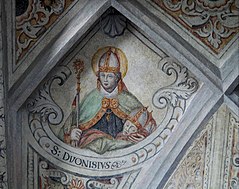Pope Dionysius
- Pope Dionysius can also refer to Pope Dionysius of Alexandria.
Pope Saint Dionysius | |
|---|---|
 | |
| Papacy began | 22 July 259 |
| Papacy ended | 26 December 268 |
| Predecessor | Sixtus II |
| Successor | Felix I |
| Personal details | |
| Born | Dionysius ??? Possibly Magna Graecia in Italy. |
| Died | 26 December 268 Rome, Roman Empire |
| Sainthood | |
| Feast day | 26 December |
| Venerated in | Roman Catholic Church |
| Attributes |
|
Pope Dionysius (died 26 December 268) served as the Bishop of Rome or Pope from 22 July 259 to his death in 268. His task was to reorganize the Roman church, after the persecutions of the Emperor Valerian I and the edict of toleration by his successor Gallienus. He also helped rebuild the churches of Cappadocia, devastated by the marauding Goths.
Biography
Dionysius may have been been born in Magna Græcia, but this has not been verified. He was elected pope in 259, after the martyrdom of Sixtus II in 258. The Holy See had been vacant for nearly a year due to difficulty in electing a new pope during the violent persecution which Christians faced.[1] When the persecution had begun to subside, Dionysius was raised to the office of Bishop of Rome. Emperor Valerian I, who had led the persecution, was captured and killed by the King of Persia in 260.[1] The new emperor, Gallienus, issued an edict of toleration, restoring the churches, cemeteries and other properties it had held, leading to the nearly 40-year "Little Peace of the Church".[2] To the new pope fell the task of reorganizing the Roman church, which had fallen into great disorder. On the protest of some of the faithful at Alexandria, he demanded from the bishop of Alexandria, also called Dionysius, explanations concerning his doctrine regarding the relation of God to the Logos, which was satisfied.[1]
Pope Dionysius sent large sums of money to the churches of Cappadocia, which had been devastated by the marauding Goths, to rebuild and to ransom those held captive. He brought order to the Church and procured a peace after Emperor Gallienus issued an edict of toleration which was to last until 303. He died on 26 December 268.[1]
In art, he is portrayed in papal vestments, along with a book.[1]
See also
Notes
References
- Herbermann, Charles, ed. (1913). . Catholic Encyclopedia. New York: Robert Appleton Company.
